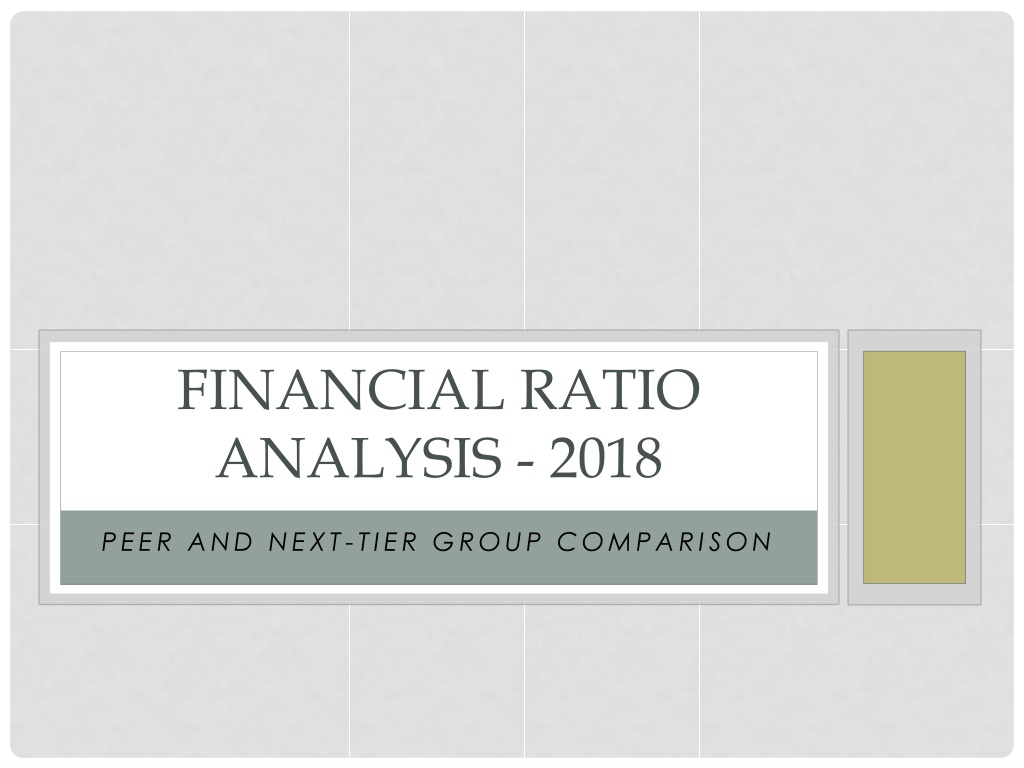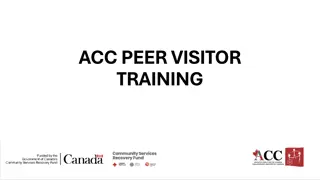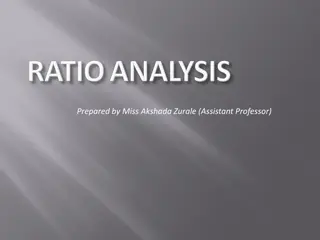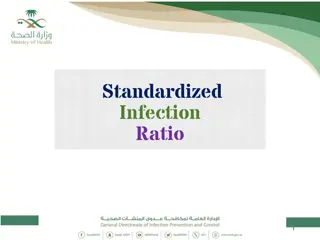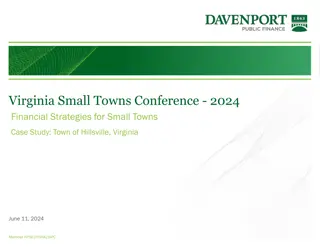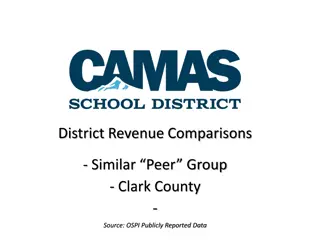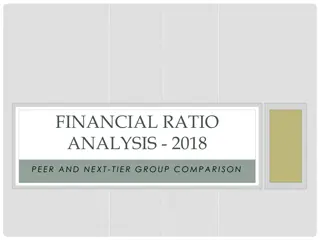Financial Ratio Analysis 2018 Peer and Next-Tier Group Comparison
This financial ratio analysis for 2018 compares the viability ratios and primary reserve ratios of various institutions within the peer and next-tier groups. The Viability Ratio assesses an institution's ability to cover its long-term debt with expendable net assets, while the Primary Reserve Ratio indicates how long an institution can operate using its reserves without relying on additional assets. The data provides insights into the financial health and stability of these educational organizations.
Uploaded on Sep 27, 2024 | 0 Views
Download Presentation

Please find below an Image/Link to download the presentation.
The content on the website is provided AS IS for your information and personal use only. It may not be sold, licensed, or shared on other websites without obtaining consent from the author. Download presentation by click this link. If you encounter any issues during the download, it is possible that the publisher has removed the file from their server.
E N D
Presentation Transcript
FINANCIAL RATIO ANALYSIS - 2018 PEER AND NEXT-TIER GROUP COMPARISON
VIABILITY RATIO Definition The Viability Ratio is calculated as Expendable Net Assets divided by Long-Term Debt. Notes and Caveats This ratio helps to answer the question: Does the institution have sufficient expendable net assets to cover its debt should we need to settle our obligations as of the balance sheet date? Source IPEDS Finance Forms (FASB)
VIABILITY - PG Mercy College 5.25 St Francis College 1.76 New York Institute of Technology 1.69 Daemen College .92 Cazenovia College .89 Hilbert College .77 College of Mount Saint Vincent .65 Vaughn College .50 Medaille College .42 Metropolitan College of New York .34 Utica College .31 Keuka College .26 Boricua College Not available
VIABILITY - NTG Alfred University 6.52 Iona College 2.09 Le Moyne College 1.75 Manhattan College 1.42 Pratt Institute 1.37 Canisius College 1.07 Wagner College .91 Molloy College .85 The College of Saint Rose .76 Vaughn College .50
PRIMARY RESERVE RATIO Definition Primary Reserve Ratio is calculated as Expendable Net Assets divided by Total Expenses. Notes and Caveats This ratio helps to answer the question: How long can the institution operate using its expendable reserves without relying on additional net assets generated by operations? Source IPEDS Finance Forms (FASB)
PRIMARY RESERVE - PG Mercy College 1.91 St Francis College 1.06 Metropolitan College of New York 0.84 Vaughn College 0.75 Daemen College 0.54 Hilbert College 0.36 Medaille College 0.28 Cazenovia College 0.27 New York Institute of Technology 0.24 College of Mount Saint Vincent 0.22 Keuka College 0.16 Utica College 0.15 Boricua College Not Available
PRIMARY RESERVE - NTG Iona College 1.56 Le Moyne College 1.48 Manhattan College 1.04 Pratt Institute 1.02 Vaughn College 0.75 Wagner College 0.69 Alfred University 0.68 Canisius College 0.65 Molloy College 0.58 College of Saint Rose 0.53
RETURN ON NET ASSETS Definition Return on Net Assets is calculated as Change in Net Assets divided by Net Assets at the Beginning of Year. Notes and Caveats This ratio helps to answer the questions: How has the institution performed in terms of generating net assets (institutional equity) compared to its capital base? Are we increasing our net assets and thereby able to set aside financial resources to strengthen our future financial flexibility? Source IPEDS Finance Forms (FASB)
RETURN ON NET ASSETS - PG Boricua College 0.78 Utica College 0.24 Daemen College 0.08 Mercy College 0.07 Metropolitan College of New York 0.03 Keuka College 0.03 College of Mount Saint Vincent 0.02 New York Institute of Technology 0.01 Medaille College 0.0 Vaughn College (0.01) St Francis College (0.05) Hilbert College (0.05) Cazenovia College (0.06)
RETURN ON NET ASSETS - NTG Manhattan College 0.14 Pratt Institute 0.09 Le Moyne College 0.07 Alfred University 0.07 Wagner College 0.06 Molloy College 0.06 Iona College 0.06 Canisius College 0.00 Vaughn College (0.01) The College of Saint Rose (0.01)
NET INCOME RATIO Definition Net Income Ratio is calculated as Net Operating Income divided by the Total Unrestricted Operating Income. Notes and Caveats This ratio helps to answer the question: Did the institution live within its means (or not) during the year? Source Vaughn 2017 Audit
NET INCOME Vaughn College -.02 Unable to calculate the net income for peers and next-tier institutions due to the difficulty in isolating components of the variable in the raw data (e.g. unrestricted operating revenue, total unrestricted revenues and gains, net assets released from restriction).
COMPOSITE FINANCIAL INDEX Definition A combination of four core ratios to produce a single measurement of financial performance. Notes and Caveats Four steps: 1. Four core ratios calculated 2. Converted to strength factors 3. Weighting of strength factors 4. Total to reach CFI Source Vaughn 2018 Audit
COMPOSITE FINANCIAL INDEX Strengths and Weights Ratio Value Strength: Divide Ratio Weight Multiply CFI Score Primary Reserve .72/.133 x .35 1.74462669 Net Income -.02/.007 x .10 -0.9384829 Return on Net Assets -.01/.02 x .20 -0.6038738 Viability 0.49/.417 x .36 .38434292 CFI Score-sum last column 1.95152008
CFI SCORING GUIDE SCALE LEVEL CFI SCORING RANGE ACTION One Assess viability of institution s survival -1 to 1 Two 0 to 2 Reengineer the institution Three 1 to 3 Four 2 to 4 Direct resources toward transformation Five 3 to 5 Six 4 to 6 Focus resources to compete Seven 5 to 7 Eight 6 to 8 Experiment with new initiatives Experiment with new initiatives; achieve a robust mission Nine 7 to 9 Deploy resources to achieve a robust mission Ten >9
